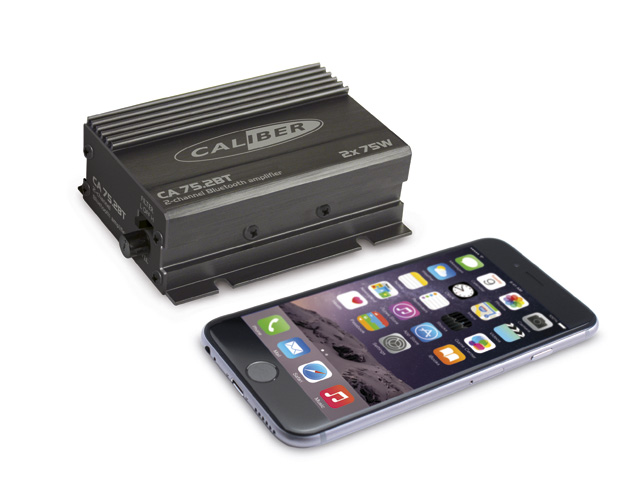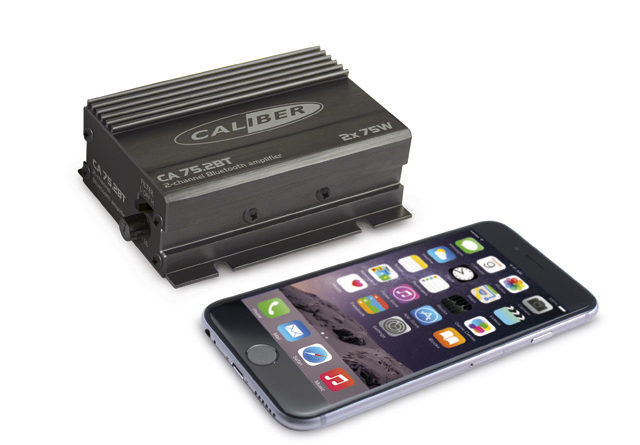CALIBER CA75.2BT 2Ch BLUETOOTH AMPLIFIER
Product Details
Manufacturer: Caliber
Distributor: Celsus
Website: link
Typical Selling price: £59.99
A very small heatsink with a pair of Molex connector plug sockets and a Bluetooth antenna wire sticking out of the end, with a tiny knob and three-way switch on the other. The plugs connect to live/ignition switched feed and earth and the speaker wires. The input is via Bluetooth.
Editor review : CALIBER CA75.2BT 2Ch BLUETOOTH AMPLIFIER
First, be aware that Bluetooth is capable of being kinda temperamental and that you just paid sixty quid for an amp with watts and everything! This is not going to be the top end. But even then, I found the connecting part a little trying. The CA75.2BT puts out a brace of Bluetooth signals, provable by multiple scans and erases to prove that the Bluetooth microchip itself, that comes up as ‘CW6638-IC-270F’ can be connected to for Mobile Audio via the A2DP streaming protocol, yet is inhibited from playing music as the ‘˜incorrect Pin’ message comes up. Then, after a delay, or sometimes not, and sometimes never until you reboot the system with an ignition off/on again, you DO see CA75.2BT CALIBER as a connection option. I managed to connect by messing until the name of the product shows up. Then it worked.
The amp at 2x25W and 4x75W peak, reads exactly like a high end ‘˜chip’ amp as found inside good quality car radios. These make exactly that power and can be impressive. (Alpine use one to drive a small active subwoofer product.) Mine was connected to a set of Caliber pod speakers called CSB1. These have their own review but were quite startling for their low cost. They are an efficient design intended for this sort of application (as well as being able to take a bit more power if you like, in this case.) and on this amp, sat in my test rig, they sang.
The main issue is the amplifier being surprisingly dynamic. I tried it out on some hippy electronica by Isao Tomita. The ‘˜Mars’ section of his rendition of Gustav Holst’s Planet Suite, complete with squeaky exchanges of horns as though call and response on two-way radios from mission control.

OK, the massive basso rocket sound was not huge as the speakers were limited in real estate and the power not big. But the highs were really clear and dynamic. So, I figured that as well as trying the weeny amp with the weeny speakers, since they are so cute together, I would also put these few watts through the mighty cast-chassis and Unicorn-rare VIETA 6×9 three ways with compression-horn loaded tweeters in the test rig. They are boxed in plywood enclosures made by FUSION Car Audio UK’s ‘˜Area 51’ department. (I wonder how may readers know or recall that snippet? I am a fount of ancient car audio history and lore.) and I have tested a great many items through them.
The grey/green wires were connected to these bad boys and I could finally hear the full meat and potatoes. The sound was startlingly full range. I admit that I MUST have been carrying prejudice or I would not have been as surprised. The highs were tinkly and the loudest-to-quietest bits were impressive. That’s ‘˜dynamics’. And it goes loud enough on the big speakers to fill the house. I made some video in real time of the issues I had with connection. It pretty much always was a bit of a pain but it did always get it in the end. And that A2DP profile really is pretty good, sound quality-wise. I played a the whole album from my desk to the test rig in the landing. It just shows that 85dB of signal to noise ratio can be acceptable and enjoyable.
All in all, despite the real issues with connecting all Bluetooth devices, let alone this one being a bit recalcitrant, I think this a truly cool product and happily recommend it for any vehicle that ‘You Cannot Install Audio Into’.
Yes, you can, with a CA75.2BT
Overall 7.6
Sound Quality 7
Power Output 6
Features 8
Build Quality 7
Value For Money 10
– Bluetooth Version: 21 (A2DP Profile)
– 2 x 25w RMS @ 4 Ohms/14.4V
– 2 x 75w maximum @ 4 Ohms/14.4V
– Aluminium heatsink
– Signal to Noise Ratio 85dB
– High Pass Filter 120Hz (±12dB)
– Low Pass Filter 80Hz (±12dB
– Fuse Rating 30A x1
– HxWxD(mm) 100 x 78 x 38mm

